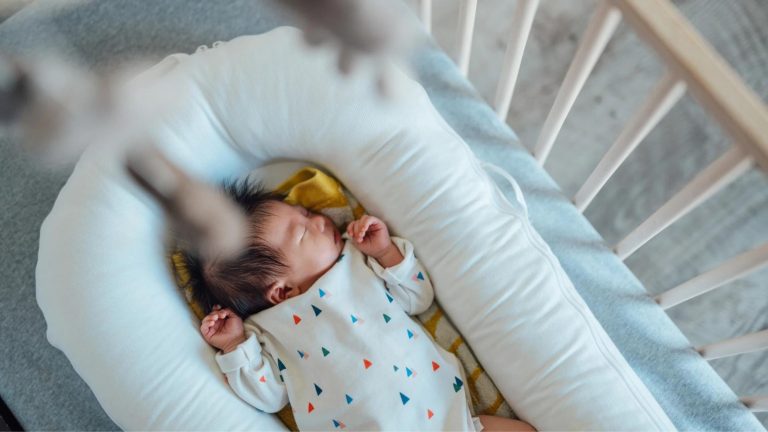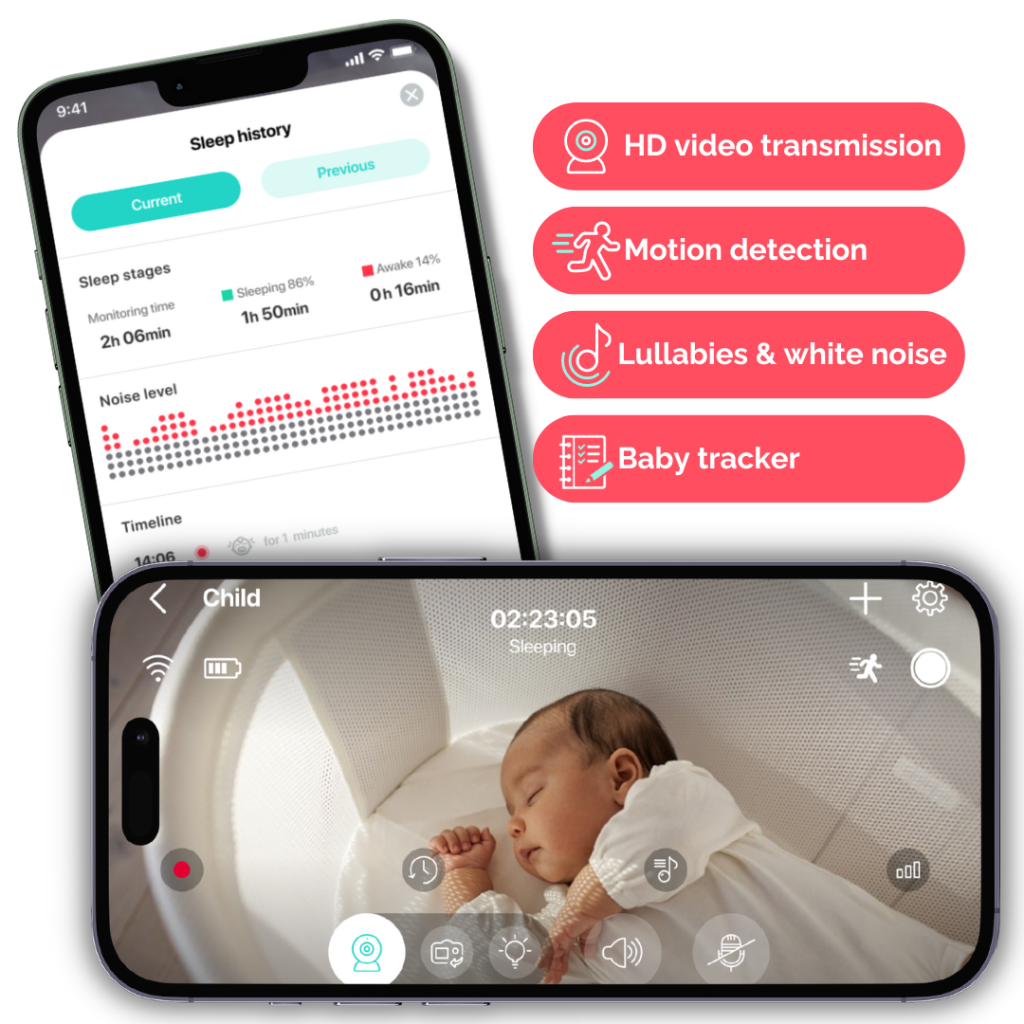
Solving Baby Sleep Puzzle: Your Guide to Understanding Newborn Sleep Cycle Charts
- Created:
1. 8. 2023 - Updated:
15. 2. 2024
Admit it:
Keeping up with newborn sleep cycles is daunting and even more difficult with the sleepless nights that come with it.
Worse still:
Not knowing newborns have sleep cycles you can easily work with is alarming.
If you’re in this boat, I have good news.
A newborn sleep cycle chart is all you need to figure out the puzzle of your baby’s sleep patterns, and this guide is all about them.
Excited?
So let’s dive in!
What Is a Newborn’s Sleep Cycle?
A newborn sleep cycle is a sequence of sleep and wake durations measured over a particular period. In other words, it refers to your baby’s total sleep and wakefulness over a stipulated time.
Furthermore:
This cycle describes a sequence of Rapid Eye Movement (REM) and Non-Rapid Eye Movement (Non-REM) sleep the infant gets over a timeframe, such as 24 hours (one day).
In essence:
The sleep chart helps you keep track of these sleep patterns and ultimately find out how much sleep your baby needs.
How Long Is a Newborn Sleep Cycle?
Fact:
Newborns spend most of their day sleeping. This is because they don’t have a sense of day and night yet, and they expel energy processing new information.
The thing is:
Contrary to what you might expect, they have completely different sleep cycles from adults.
That’s right!
While an adult could spend eight straight hours asleep, babies sleep for shorter periods that would count as naps for an adult. For this reason, adults have considerably longer sleep cycles than newborns.
Now:
BetterHealth reports that newborns could sleep in short bursts that could last as little as 20 minutes or as much as 50 minutes.
Moreover:
A newborn’s sleep cycle generally lasts 45 to 60 minutes per sleep session. And the cycle varies with the age of your newborn and its characteristics.
For babies between 0 to 1 month of age, their sleep cycle usually lasts around 50 to 60 minutes per sleep session. According to SleepFoundation, they could sleep for a total of 16 to 18 hours a day.
Also:
Babies between 1 to 3 months of age generally have similar individual sleep durations of 50 to 60 minutes, like newborns. But they spend more time awake.
Check out the newborn sleep cycle chart we’ve provided below to help you understand newborn sleep cycles better.
| Age | Sleep duration per period | Sleep duration in 24 hours (one day) | Sleep duration per night | Daytime sleep duration (nap duration) | Sleep patternfeatures |
| 0-1 months (Newborn) | 50-60 minutes | 16-18 hours | Equally divided between day | Breastfed babies usually sleep for around 2-3 hours; bottle-fed babies sleep for around 3-4 hours | N-REM and REM sleep cycles. They wake up frequently. |
| 1-3 months | 50-60 minutes | 14-17 hours | 8-9 hours | 4-5 naps, each lasting around 1.5 hours. | Relatively more stable and predictable sleep patterns; Sleeps for longer periods; Nighttime sleep stretches longer. |

Stages of a Newborn Sleep Cycle
Get this:
In a newborn sleep cycle, the baby’s sleep progresses from one stage to another, with each stage being deeper than the last. They generally get drowsy first, then fall into progressively deeper stages of sleep.
Thus:
To properly understand how your newborn’s sleep cycle works, you must first know the stages of sleep in infants. There are two primary stages in a newborn sleep cycle: light sleep and deep sleep.
In this section, we will properly describe both stages of sleep and what happens in each one.
Buckle up!
1. Light Sleep
Fundamentally:
The light sleep stage is the first phase of infant sleep.
At this point, changes in their surroundings, like noise or movement, have the potential to wake them. However, it doesn’t take too long after this stage for deep sleep to set in.
Usually:
In this period, they move around, experience eye twitches, and might make sounds while asleep. This might lead you to think that the baby is awake or seeking attention.
Well, this is not the case!
During the light stage in infant sleep, the blood flow to the brain is increased, thus increasing brain activity and development.
Hence, light sleep is essential for your newborn’s growth.
To improve your baby’s light sleep, you can use pacifiers, adequate pre-bedtime meals, and ensure a safe, comfortable sleeping environment.
2. Deep Sleep
The second stage of sleep in newborns is deep sleep. In this stage, the baby experiences little to no eye movements, reduced muscle motion, and less sensitivity to noises as well.
Essentially:
Once a baby drifts into a deep sleep, their body becomes less active. Thus, they are less likely to wake up due to external disturbances like sounds or movements.
Typically:
The deep stage of sleep is the period when babies alternate between active (REM) sleep and quiet (Non-REM) sleep.
In Rapid Eye Movement (REM) or active sleep, the baby’s brain shows relatively high reactivity than in Non-REM sleep. Here, you can be sure of eye and muscle movements by the baby while sleeping.
On the other hand:
In Non-Rapid Eye Movement (Non-REM) sleep, the baby experiences quiet sleep, which comes with lesser body movements and twitches.
Take note:
Generally, REM sleep in newborns lasts longer than Non-REM. Babies spend around 50% of their time asleep in REM, and at this phase, the baby drifts into their dreams.
Primarily:
Deep sleep is important for newborns because, during this period, they get the rest they need. They also obtain the energy to process more information and develop properly.
Now:
The sleep cycle for newborns is divided into various stages, with each one leading into a progressively deeper slumber. Here is a table to help you understand the stages of your newborn sleep cycle.
| Stage | Description | Duration |
| Drowsiness | This is the transition between wakefulness and sleep. The baby begins to show signs of sleepiness, such as yawning, eyes fluttering open, and sucking of fingers. | Few minutes |
| Light sleep (stage one) | Baby just starts to fall asleep. Eye and muscle movements slow down, but the baby can easily wake up due to noise or discomfort. | 5-10 minutes |
| Light sleep (stage two) | Baby’s eye movements cease, and their brain activity reduces. | 10-15 minutes |
| Deep sleep | The baby enters a state of deep sleep with no muscle or eye movements. In this stage, the baby is less sensitive to noise or movements. | 20-40 minutes |
| REM | Here, the baby’s brain activity increases, which is associated with rapid eye movements, muscle twitches, and dreaming. The baby may experience normal periodic breathing during infancy which is a short period of 5-10 seconds when they cease to breathe. | 50% of the newborn sleep cycle |
How Does a Newborn’s Sleep Cycle Change As They Grow?
Want to know a secret?
Your newborn’s sleep cycle changes as they grow, and that’s completely normal.
You see:
As a baby grows, their sleep cycles become longer and more stabilized.
This means that the older your infant gets, the less time they spend awake at night. This is because they develop a sense of day and nighttime, thus enabling them to know when and when not to sleep.
For this reason:
A three-month-old would spend longer individual periods asleep and less time awake at night than a one-month-old.
In addition:
Babies around three months of age settle into a sleep pattern with longer sleep times, according to HealthyWA. In fact, by the time the baby is six months old, their sleep cycle will resemble yours as an adult.
During this period, parents find monitoring their baby’s sleep easier since it doesn’t cut into theirs.
But, before the transition:
It’s always difficult when trying to keep up with your baby’s sleep patterns and find ways to optimize their sleep. And it would only get more difficult if the baby keeps changing sleep patterns.
Now you’re probably wondering: How do I adjust to my baby’s sleep pattern without letting it affect my sleeping routine?
The answer is simple:
You have to keep track of your baby’s sleep cycles using newborn sleep cycle charts. Monitoring their wake windows to find out what’s best for your baby is also a good idea.
Final Tip: Annie Baby Monitor – Your Baby Sleep Solution Helper
Learn all about your baby’s sleep cycles with Annie Baby Monitor, your go-to helper for understanding your little one’s snooze patterns.
With its advanced features – sleep history and sleep tracker, you can easily track and analyze your baby’s sleep cycles, giving you the knowledge you need to create the perfect sleep routine.

Say goodbye to fussy baby and let Annie Baby Monitor guide you through the world of newborn sleep cycle charts, ensuring your baby gets the peaceful and restful sleep they need.
Conclusion
Let’s wrap up:
Baby sleep cycles can be a tough nut to crack. But with the right techniques, such as applying a newborn sleep cycle chart, you can get the hang of it easily.
Note:
Newborns sleep in two stages: Light Sleep and Deep Sleep. Between these stages, the baby experiences alternated periods of REM and Non-REM, both of which are important to their development.
During light sleep, infants experience:
- Slowed muscle and eye movements
- High tendency to wake up due to slight discomfort or noise
- Periodic drifting in and out of sleep
On the other hand, deep sleep has the following characteristics:
- Ceased eye movement
- Ceased muscle movement
- Sleep that you can’t easily interrupt
Remember:
Infant sleep is vital, so you must find ways to optimize their sleep and improve their sleep patterns.
For instance, you could ensure that the baby sleeps safely and comfortably by wrapping them in adequate clothing. You can also utilize a baby monitor to keep an eye out for your baby even when you’re not at home.
So go ahead:
Leave a comment below if you found this article helpful. If you have questions, suggestions, or concerns about newborn sleep cycle charts, feel free to leave a comment as well.
FAQ: Newborn Sleep Cycle Charts
The older your infant gets, the more their sleep cycle becomes longer and more consolidated. For example, while newborns (a month old or less) have relatively shorter sleep durations, 3-month-old babies sleep for longer individual periods.
Newborns typically sleep for 45-60 minutes per sleep session and 16-18 hours per day. This varies because all babies are different, and other factors, like sleeping conditions, come into play.
You can use a sleep cycle chart to monitor the length of your baby’s sleep and gauge if they are getting enough sleep. You can also use it to plan when your baby should sleep so it can adjust to the routine and get its much-needed rest.






